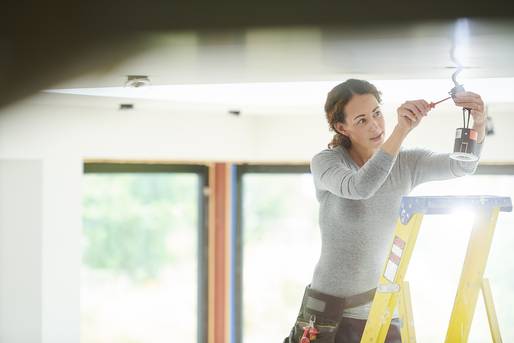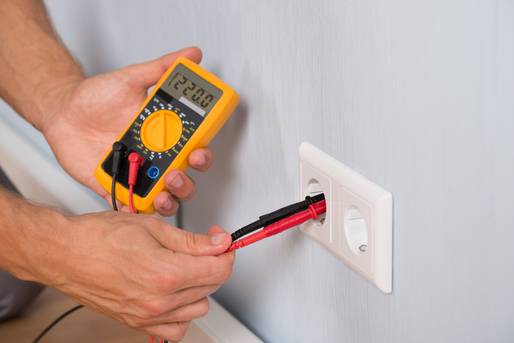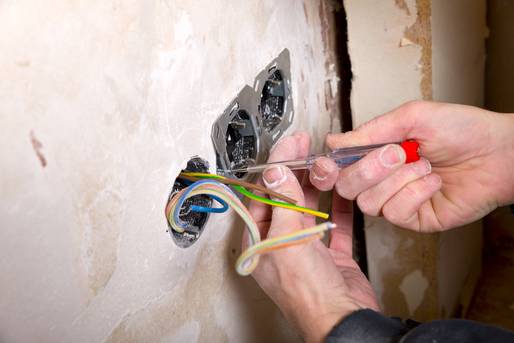Electrical renovation » You can do this electrical work yourself
Published: 24.11.2023 | Reading Time: 6 minutes
This text is machine translated.
The painting or wallpapering work involved in a modernization project can easily be carried out by anyone throughout the house. The specialist knowledge required is fairly straightforward. A little practice and some experience quickly guarantee perfect results.
But what if a wall or ceiling lamp has to be disconnected and removed while painting or wallpapering? And what if an old power socket wobbles and no longer makes proper contact?
In addition, when renovating, there is often a desire to relocate an existing power socket on the wall or install an additional socket. This makes perfect sense in this case. This is because the slots required for the cable and empty conduits can be closed with plaster and covered with paint or wallpaper.
But can ambitious DIY enthusiasts without specialist training do this themselves or are trained specialists required? We tell you what the legal situation allows and what you should not do.
If you visit the electrical department of a DIY store, you can find shelves of switches, sockets, cables, fuses, lamps and more. This inevitably gives the impression that anyone who has ever heard of phase, neutral and earth conductors can screw and clamp the electrical installation to their heart's content during renovation work.
But unfortunately this is a fallacy. In Germany, the electrical trade is one of the trades that requires a license. In addition, the electrical trade is subject to the master craftsman requirement and is a hazardous trade.
Low-voltage connection ordinance relevant
Although the mains voltage of 230 V or 400 V seems quite high compared to the voltages of batteries or accumulators to the layman, experts refer to domestic installations as a low-voltage network. This is because there are other voltage levels in connection with electricity grids, where the voltages can be up to 380 kV (380,000 V).
The relationship between energy suppliers and electricity consumers is regulated in the Low Voltage Connection Ordinance (NAV). Section 13 precisely defines that, in addition to the grid operator, only an installation company that is also entered in the grid operator's register of installers may carry out the work required for electrical installations.
This does not apply to maintenance work that is carried out after the metering device (electricity meter). However, this exception is not a carte blanche for non-specialists. This is because the NAV also clearly states that all installation, extension, modification and maintenance work must be carried out in accordance with the applicable legal regulations and the generally recognized rules of technology. And ultimately, only specialists who have the necessary specialist knowledge of the DIN standards and VDE regulations to be observed due to their training are able to do this.
Based on the above-mentioned Low Voltage Connection Ordinance, all work that may be carried out by non-professionals during electrical renovation can be derived. Ultimately, these are all activities that are carried out in a safe manner. Whereby contact safety refers to contact with live parts such as wires, electrical cables or terminals.
Touch-safe activities include, for example, plugging an electrical device into a mains socket. Replacing lamps is also permitted if the power supply has been switched off beforehand.
This also includes switching on an electrical circuit breaker or residual current circuit breaker if it has previously been triggered. However, if an appliance or an outdated cable in the house is faulty and the circuit breaker or RCD is repeatedly triggered, a specialist must rectify the fault.
Unplugging ceiling lights is also permitted for non-professionals if a specialist has disconnected the light from the power supply beforehand.
Even with extensive installation work, non-specialists can actively help with electrical engineering and thus save real money. This includes activities such as
- Chiseling slots
- Laying empty conduits for new cables
- Laying cables in empty conduits
- Installing flush-mounted boxes
- Installing distributors
- Carry out installation work
To ensure that the results of the electrical renovation work to be carried out meet today's requirements, they should always be carried out in close consultation with the relevant electrician. This ensures that the work is carried out correctly and that the correct material is used.
As soon as the activities that have to be carried out during the renovation of the electrical installation are no longer safe to touch, they may not be carried out by “non-specialists”.
Strictly speaking, it is not legally permissible for non-professionals to disconnect lights from the power supply during renovation work and reconnect them after the renovation.
After all, the proper function of the ceiling light connection must be checked after it has been reconnected. However, this does not just mean the basic lighting function of the lamp.
It is also necessary to check whether the required protective conductor is functioning correctly in the case of luminaires with metal housings and thus whether the prescribed protection is provided in the event of a fault. This requires measuring equipment that not everyone has at their disposal.
The grid operator or regional electricity supplier is responsible for the correct and safe electrical installation up to the house connection fuse.
The owner of the house or apartment is responsible for the electrical system after the house connection fuse.
Caution should therefore be exercised. The consequences of a faulty or incorrectly installed electrical system can be overvoltage, short circuit, cable fire or electric shock.
If it then transpires that the fault in the installation was caused by an unqualified person, the insurance cover will lapse in many cases.
For this reason, you should really think carefully about whether you should carry out the necessary electrical renovation work yourself or leave it to a qualified electrician.
Legal requirements, specific areas of responsibility and clearly formulated insurance conditions ensure a clear situation when it comes to electrical installations: laypersons are not permitted to intervene between the power supply and the socket. Even replacing a light switch or a socket and connecting a ceiling light or wall light are not permitted.
Unfortunately, things often look very different in practice. Either the experts don't have time for the less lucrative small jobs or the high costs for travel and working time put many people off, so no order is placed.
In such cases, people often reach for a screwdriver themselves out of necessity when carrying out renovation work. After all, connecting a new socket, replacing a light switch or installing a lamp are, in principle, quite easy to do.
However, people who do this should know exactly what they are doing. They must also be aware that they must take full responsibility for their actions.
In rented apartments, it should be clarified before moving in whether a socket is missing somewhere, as it is then the landlord's responsibility to remedy the situation. Subsequent changes to the electrical installation and the assumption of the costs incurred must be clarified with the landlord before the work is carried out.
Can socket outlet covers be removed for wallpapering?
Unscrewing a socket cover does not ultimately constitute direct interference with the building's electrical system. However, before the cover is removed, the power supply for the room in question must be switched off and the absence of voltage checked. It must also be ensured that the power is not unknowingly switched back on by other people during the renovation work. It must also be ensured that no paint or wallpaper paste penetrates the open socket insert during renovation work and causes malfunctions.
Can switch covers be removed for wallpapering?
The situation with switch covers is similar to that with sockets. Since only the plastic frame is removed, this does not legally constitute interference with the electrical installation. However, the same protective measures must be taken with switches as with sockets.
Additional wall socket or multiple socket?
Multiple sockets offer the option of operating several loads from one mains socket. However, the power of the connected loads must be taken into account. Even if the multiple socket outlet is technically up to date, the maximum connected load must not exceed 3680 W (230 V x 16 A). In addition, all consumers are connected to one circuit and one fuse. This can quickly lead to problems. If the connected electrical systems and appliances require so much power, it would be technically the better solution to have additional wall sockets installed, which are then also separately fused.





